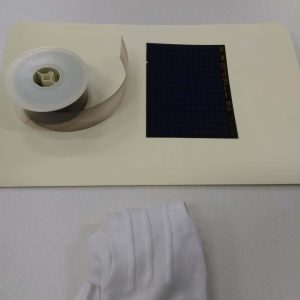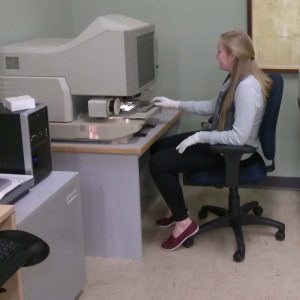
Microfilm and microfiche at the Chilliwack Museum and Archives.
Have you ever wondered what that old looking machine tucked away in the back of the research room is and what it is used for? Is it a really old computer? Is it a machine used to watch videos on an older format? Perhaps it is used to digitize images? In fact, it is a microfilm/microfiche reader. Now you may be asking, what is microfilm/microfiche and why is it used at the archives?
According to the Society of American Archivist, microfilm is “transparent film containing highly reduced copies of documents.” Similar to microfilm, microfiche is “a sheet of transparent film [with] microimages arranged in rows and columns, usually with an area for eye-readable description at the top.” In layman’s terms, this means that both microfilm and microfiche are tiny images of documents on either a rolled film or a flat sheet, respectively. At its core, the microfilm reader is just a big magnifying glass that shines a light through the film allowing the researcher to read the microfilm or microfiche.

Summer intern Rachel Vandenberg doing property research on microfilm, May 16, 2017.
What makes microfilm and microfiche so indispensable to archives is its preservation and access value. To touch on the latter first, all you need to read microfilm or microfiche is light and a magnifying glass. There is no need to worry about special computer programs, obsolete machinery, or corrupted digital files. To be fair, searching through microfilm or microfiche can be significantly time consuming when compared to digital keyword searchable files. However, should the medium for whatever technology you are using in the future fail–as all things do at some point–you will still be able to read and access the information on microfilm and/or microfiche with a magnifying glass and a flashlight.
Microfilm/microfiche is also a fantastic resource for preserving archival records. As the name implies, microfilm/microfiche is a miniature version of the original document. The information on an old municipal tax roll that is 40 x 50 x 17 cm can fit into a 10 x 10 x 4 cm microfilm roll. As limited space is a concern for nearly every archive, microfilm/microfiche is a great resource for storing the historical data of these records. Furthermore, stored properly microfilm/microfiche has a minimum life expectancy of 500 years. This is why so many archives have microfilmed their newspaper collections, which are often made of highly acidic and easily degradable paper.
There is nothing glamorous about microfilm or microfiche and doing research on these mediums is time consuming. However, microfilm and microfiche are tried-and-true preservation resources. Consider them another tool in the archivist toolkit that is likely to stick around for the foreseeable future. Chances are, if you are doing property ownership research and looking at old township tax rolls at the Chilliwack Museum and Archives, you will likely have the opportunity to use that strange-looking machine in the back of the research room.

Comments are closed.